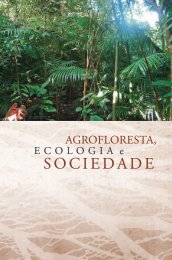Evolution of Oviductal Gestation in Amphibians
Evolution of Oviductal Gestation in Amphibians
Evolution of Oviductal Gestation in Amphibians
Create successful ePaper yourself
Turn your PDF publications into a flip-book with our unique Google optimized e-Paper software.
402 M.H. WAKE<br />
Fig. 7. Salamandra atra female (68.0 mm SVL) and near-<br />
birth young excised from the oviduct. Note the triramous gills<br />
still present.<br />
than half <strong>of</strong> the known species are obligately vi-<br />
viparous (Wake, '77a,b, '82, '89, '92). These species<br />
are found <strong>in</strong> three <strong>of</strong> the six families <strong>of</strong> caecilians,<br />
and it is apparent that viviparity has evolved at<br />
least twice, once <strong>in</strong> the Old World (caeciliads and<br />
scolecomorphids) and once <strong>in</strong> the New World (cae-<br />
ciliads and typhlonectids). It is possible that vivi-<br />
parity arose <strong>in</strong>dependently <strong>in</strong> scolecomorphids and<br />
<strong>in</strong> typhlonectids, but until relationships with<strong>in</strong> and<br />
among these groups is better understood, this re-<br />
ma<strong>in</strong>s speculative. Several caeciliaids are direct<br />
developers, and members <strong>of</strong> that family and the more<br />
primitive Rh<strong>in</strong>atrematidae, Ichthyophiidae, and<br />
Uraeotyphlidae are oviparous. In apparently all <strong>of</strong><br />
the egg layers, direct developers or not, the female<br />
guards the clutch, at least for a time. In contrast<br />
to other amphibian groups, <strong>in</strong> which viviparous spe-<br />
cies are term<strong>in</strong>al taxa <strong>in</strong> genera that also <strong>in</strong>clude<br />
ovoviviparous forms, there are apparently no ovo-<br />
viviparous caecilians. They either provide mater-<br />
nal nutrition, or they lay their clutch shortly after<br />
it is fertilized <strong>in</strong>ternally.<br />
All caecilians are presumed to use <strong>in</strong>ternal fer-<br />
tilization. The mechanism differs from that <strong>of</strong> frogs<br />
and salamanders. Male caecilians evert the rear part<br />
<strong>of</strong> the cloaca as a phallodeum and <strong>in</strong>sert it <strong>in</strong>to the<br />
vent <strong>of</strong> the female. (Effectively noth<strong>in</strong>g is known<br />
<strong>of</strong> mate location or courtship <strong>in</strong> caecilians, though<br />
copulation has been observed <strong>in</strong> Chthonerpeton<br />
and Z'yphlonectes [Barrio, '69; Billo et al., '85; Murphy<br />
et al., '77; Exbrayat and Laurent, '83; Exbrayat et al.,<br />
'831). Birth was first reported by He<strong>in</strong>roth ('15). The<br />
morphology <strong>of</strong> the phallodeum apparently is species-<br />
specific, with patterns <strong>of</strong> longitud<strong>in</strong>al and transverse<br />
connective tissue ridges <strong>in</strong> all species and paired,<br />
posteriorly-open<strong>in</strong>g sacs <strong>in</strong> many (Tonutti, '31, '33;<br />
Wake, '72). Contraction <strong>of</strong> body wall musculature,<br />
fill<strong>in</strong>g <strong>of</strong> vascular s<strong>in</strong>uses, and hydrodynamics <strong>of</strong><br />
the phallodeal sacs have all been implicated as <strong>in</strong>-<br />
volved <strong>in</strong> the mechanism <strong>of</strong> eversion (Taylor, '68),<br />
but none <strong>of</strong> these have been demonstrated.<br />
Males have an additional adaptation for <strong>in</strong>ternal<br />
fertilization that Wake ('81) considered correlated<br />
with terrestriality <strong>of</strong> reproduction. The posterior<br />
10-30 mm <strong>of</strong> the paired Mullerian ducts (which early<br />
<strong>in</strong> embryology develop <strong>in</strong> both males and females,<br />
but which regress early <strong>in</strong> most males, and become<br />
the oviducts <strong>of</strong> all females except teleosts) becomes<br />
a glandular structure (Fig. 10) <strong>in</strong> male caecilians<br />
(Tonutti, '31, '33; Wake, '81; Exbrayat, '85). It is se-<br />
cretory dur<strong>in</strong>g the active spermatogenic phase <strong>of</strong><br />
the testis, and regressed when the testis is, so the<br />
Mullerian gland presumably is respond<strong>in</strong>g to the<br />
same hormonal regime. Wake ('81) suggested that<br />
the Mullerian gland is the homologue <strong>of</strong> the turtle<br />
and mammal prostate gland (the medial prostate<br />
<strong>of</strong> mammals is <strong>of</strong> Mullerian duct orig<strong>in</strong>; references<br />
<strong>in</strong> Wake, ,811, and she demonstrated that the con-<br />
tent <strong>of</strong> the glandular secretion is similar to that <strong>of</strong><br />
mammalian ejaculate <strong>in</strong> sugars, ions, etc. She also<br />
postulated that provision <strong>of</strong> fluid for transport and<br />
nutrients for sperm is a concomitant <strong>of</strong> terrestrial<br />
reproduction.<br />
Both ovum size and ovum number are reduced<br />
<strong>in</strong> viviparous caecilians, as they are <strong>in</strong> other vi-<br />
viparous amphibians. However, <strong>in</strong> contrast to the<br />
situation <strong>in</strong> frogs and salamanders <strong>in</strong> which direct<br />
developers have the largest, yolkiest eggs, ovipa-<br />
rous caecilians with free-liv<strong>in</strong>g larvae have the larg-<br />
est ova (8 x 10 mm), direct-developers moderate-sized






